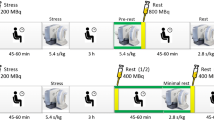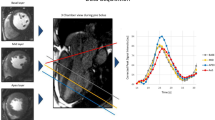Abstract
In this study, we sought to investigate the impact of baseline calibration, which is used in quantitative cardiac MRI perfusion analysis to correct for surface coil inhomogeneity and noise, on myocardial perfusion reserve index (MPRI) and its contribution to previously reported paradoxical low MPRI < 1.0 in patients with unobstructed coronary arteries. Semiquantitative perfusion analysis was performed in 20 patients with unobstructed coronary arteries undergoing stress/rest perfusion CMR and in ten patients undergoing paired rest perfusion CMR. The following baseline calibration settings were compared: (1) baseline division, (2) baseline subtraction and (3) no baseline calibration. In uncalibrated analysis, we observed ~ 20% segmental dispersion of signal intensity (SI)-over-time curves. Both baseline subtraction and baseline division reduced relative dispersion of t0-SI (p < 0.001), but only baseline division corrected for dispersion of peak-SI and maximum upslope also (p < 0.001). In the assessment of perfusion indices, however, baseline division resulted in paradoxical low MPRI (1.01 ± 0.23 vs. 1.63 ± 0.38, p < 0.001) and rest perfusion index (RPI 0.54 ± 0.07 vs. 0.94 ± 0.12, p < 0.001), respectively. This was due to a reversed ratio of blood-pool and myocardial baseline-SI before the second perfusion study caused by circulating contrast agent from the first injection. In conclusion, baseline division reliably corrects for inhomogeneity of the surface coil sensitivity profile facilitating comparisons of regional myocardial perfusion during hyperemia or at rest. However, in the assessment of MPRI, baseline division can lead to paradoxical low results (even MPRI < 1.0 in patients with unobstructed coronary arteries) potentially mimicking severely impaired perfusion reserve. Thus, in the assessment of MPRI we propose to waive baseline calibration.





Similar content being viewed by others
Abbreviations
- CAD:
-
Coronary artery disease
- CI:
-
Confidence interval
- CMD:
-
Coronary microvascular disease
- CMR:
-
Cardiac MRI
- CoV:
-
Coefficient of variation
- ECG:
-
Electrocardiogram
- EDV:
-
End-diastolic volume
- ICC:
-
Intra-class correlation coefficient
- LVEF:
-
LV ejection fraction
- ESV:
-
End-systolic volume
- LGE:
-
Late gadolinium enhancement
- LV:
-
Left ventricular
- MPRI:
-
Myocardial perfusion reserve index
- MRI:
-
Magnetic resonance imaging
- PD:
-
Proton density
- RPI:
-
Rest perfusion index
- RU:
-
Relative upslope
- SI:
-
Signal intensity
- SD:
-
Standard deviation
References
Kiaos A, Tziatzios I, Hadjimiltiades S, Karvounis C, Karamitsos TD (2018) Diagnostic performance of stress perfusion cardiac magnetic resonance for the detection of coronary artery disease: a systematic review and meta-analysis. Int J Cardiol 252:229–233
Liu A, Wijesurendra RS, Liu JM et al (2018) Diagnosis of microvascular angina using cardiac magnetic resonance. J Am Coll Cardiol 71(9):969–979
Thomson LE, Wei J, Agarwal M et al (2015) Cardiac magnetic resonance myocardial perfusion reserve index is reduced in women with coronary microvascular dysfunction. A National Heart, Lung, and Blood Institute-sponsored study from the Women's Ischemia Syndrome Evaluation. Circ Cardiovasc Imaging 8(4):e002481
Zorach B, Shaw PW, Bourque J et al (2018) Quantitative cardiovascular magnetic resonance perfusion imaging identifies reduced flow reserve in microvascular coronary artery disease. J Cardiovasc Magn Reson 20(1):14
Utz W, Niendorf T, Wassmuth R, Messroghli D, Dietz R, Schulz-Menger J (2007) Contrast-dose relation in first-pass myocardial MR perfusion imaging. J Magn Reson Imaging 25(6):1131–1135
Mordini FE, Haddad T, Hsu LY et al (2014) Diagnostic accuracy of stress perfusion CMR in comparison with quantitative coronary angiography: fully quantitative, semiquantitative, and qualitative assessment. JACC Cardiovasc Imaging 7(1):14–22
Hoffmann MH, Schmid FT, Jeltsch M et al (2005) Multislice MR first-pass myocardial perfusion imaging: impact of the receiver coil array. J Magn Reson Imaging 21(3):310–316
Murakami JW, Hayes CE, Weinberger E (1996) Intensity correction of phased-array surface coil images. Magn Reson Med 35(4):585–590
Jerosch-Herold M, Seethamraju RT, Swingen CM, Wilke NM, Stillman AE (2004) Analysis of myocardial perfusion MRI. J Magn Reson Imaging 19(6):758–770
Shufelt CL, Thomson LE, Goykhman P et al (2013) Cardiac magnetic resonance imaging myocardial perfusion reserve index assessment in women with microvascular coronary dysfunction and reference controls. Cardiovasc Diagn Ther 3(3):153–160
Ibrahim T, Nekolla SG, Schreiber K et al (2002) Assessment of coronary flow reserve: comparison between contrast-enhanced magnetic resonance imaging and positron emission tomography. J Am Coll Cardiol 39(5):864–870
Lockie T, Ishida M, Perera D et al (2011) High-resolution magnetic resonance myocardial perfusion imaging at 3.0-Tesla to detect hemodynamically significant coronary stenoses as determined by fractional flow reserve. J Am Coll Cardiol 57(1):70–75
Rieber J, Huber A, Erhard I et al (2006) Cardiac magnetic resonance perfusion imaging for the functional assessment of coronary artery disease: a comparison with coronary angiography and fractional flow reserve. Eur Heart J 27(12):1465–1471
Costa MA, Shoemaker S, Futamatsu H et al (2007) Quantitative magnetic resonance perfusion imaging detects anatomic and physiologic coronary artery disease as measured by coronary angiography and fractional flow reserve. J Am Coll Cardiol 50(6):514–522
Al-Saadi N, Nagel E, Gross M et al (2000) Improvement of myocardial perfusion reserve early after coronary intervention: assessment with cardiac magnetic resonance imaging. J Am Coll Cardiol 36(5):1557–1564
Jahnke C, Gebker R, Manka R, Schnackenburg B, Fleck E, Paetsch I (2010) Navigator-gated 3D blood oxygen level-dependent CMR at 3.0-T for detection of stress-induced myocardial ischemic reactions. JACC Cardiovasc Imaging 3(4):375–384
Cullen JH, Horsfield MA, Reek CR, Cherryman GR, Barnett DB, Samani NJ (1999) A myocardial perfusion reserve index in humans using first-pass contrast-enhanced magnetic resonance imaging. J Am Coll Cardiol 33(5):1386–1394
Anagnostopoulos C, Almonacid A, El Fakhri G et al (2008) Quantitative relationship between coronary vasodilator reserve assessed by 82Rb PET imaging and coronary artery stenosis severity. Eur J Nucl Med Mol Imaging 35(9):1593–1601
Akinboboye OO, Idris O, Chou RL, Sciacca RR, Cannon PJ, Bergmann SR (2001) Absolute quantitation of coronary steal induced by intravenous dipyridamole. J Am Coll Cardiol 37(1):109–116
Raman SV, Phatak K, Hoyle JC et al (2011) Impaired myocardial perfusion reserve and fibrosis in Friedreich ataxia: a mitochondrial cardiomyopathy with metabolic syndrome. Eur Heart J 32(5):561–567
Narang A, Mor-Avi V, Bhave NM et al (2016) Large high-density lipoprotein particle number is independently associated with microvascular function in patients with well-controlled low-density lipoprotein concentration: a vasodilator stress magnetic resonance perfusion study. J Clin Lipidol 10(2):314–322
Narang A, Blair JE, Patel MB et al (2018) Myocardial perfusion reserve and global longitudinal strain as potential markers of coronary allograft vasculopathy in late-stage orthotopic heart transplantation. Int J Cardiovasc Imaging 34(10):1607–1617
Mavrogeni S, Bratis K, van Wijk K et al (2012) Myocardial perfusion-fibrosis pattern in systemic sclerosis assessed by cardiac magnetic resonance. Int J Cardiol 159(3):e56–e58
Mavrogeni S, Bratis K, Papachristou P et al (2013) Stress perfusion-fibrosis cardiac magnetic resonance detects early heart involvement in young asymptomatic, homozygous familial hyperlipidemia with normal routine non-invasive evaluation. Int J Cardiol 168(4):4570–4572
Mavrogeni S, Bratis K, Koutsogeorgopoulou L et al (2017) Myocardial perfusion in peripheral Raynaud's phenomenon. Evaluation using stress cardiovascular magnetic resonance. Int J Cardiol 228:444–448
Bratis K, Kattamis A, Athanasiou K et al (2013) Abnormal myocardial perfusion-fibrosis pattern in sickle cell disease assessed by cardiac magnetic resonance imaging. Int J Cardiol 166(3):e75–e76
Bratis K, Chiribiri A, Hussain T et al (2015) Abnormal myocardial perfusion in Kawasaki disease convalescence. JACC Cardiovasc Imaging 8(1):106–108
Rimoldi O, Schafers KP, Boellaard R et al (2006) Quantification of subendocardial and subepicardial blood flow using 15O-labeled water and PET: experimental validation. J Nucl Med 47(1):163–172
Gould KL (2009) Does coronary flow trump coronary anatomy? JACC Cardiovasc Imaging 2(8):1009–1023
Kremers FP, Hofman MB, Groothuis JG et al (2010) Improved correction of spatial inhomogeneities of surface coils in quantitative analysis of first-pass myocardial perfusion imaging. J Magn Reson Imaging 31(1):227–233
Hsu LY, Rhoads KL, Holly JE, Kellman P, Aletras AH, Arai AE (2006) Quantitative myocardial perfusion analysis with a dual-bolus contrast-enhanced first-pass MRI technique in humans. J Magn Reson Imaging 23(3):315–322
Nagel E, Klein C, Paetsch I et al (2003) Magnetic resonance perfusion measurements for the noninvasive detection of coronary artery disease. Circulation 108(4):432–437
Van Beek JH, Roger SA, Bassingthwaighte JB (1989) Regional myocardial flow heterogeneity explained with fractal networks. Am J Physiol 257(5 Pt 2):H1670–H1680
Bassingthwaighte JB, Beard DA, Carlson BE, Dash RK, Vinnakota K (2012) Modeling to link regional myocardial work, metabolism and blood flows. Ann Biomed Eng 40(11):2379–2398
Nielles-Vallespin S, Kellman P, Hsu LY, Arai AE (2015) FLASH proton density imaging for improved surface coil intensity correction in quantitative and semi-quantitative SSFP perfusion cardiovascular magnetic resonance. J Cardiovasc Magn Reson 17:16
Larghat AM, Maredia N, Biglands J et al (2013) Reproducibility of first-pass cardiovascular magnetic resonance myocardial perfusion. J Magn Reson Imaging 37(4):865–874
Hsu LY, Kellman P, Arai AE (2008) Nonlinear myocardial signal intensity correction improves quantification of contrast-enhanced first-pass MR perfusion in humans. J Magn Reson Imaging 27(4):793–801
Stegehuis VE, Wijntjens GW, Murai T, Piek JJ, van de Hoef TP (2018) Assessing the haemodynamic impact of coronary artery stenoses: intracoronary flow versus pressure measurements. Eur Cardiol 13(1):46–53
Dietrich O, Reiser MF, Schoenberg SO (2008) Artifacts in 3-T MRI: physical background and reduction strategies. Eur J Radiol 65(1):29–35
Bravo PE, Di Carli MF, Dorbala S (2017) Role of PET to evaluate coronary microvascular dysfunction in non-ischemic cardiomyopathies. Heart Fail Rev 22(4):455–464
Funding
This study was funded by the Robert Bosch Stiftung and the Berthold Leibinger Stiftung.
Author information
Authors and Affiliations
Corresponding author
Ethics declarations
Conflict of interest
The authors declare that they have no conflict of interest.
Ethical approval
Approval from the local ethics committee was obtained and all data acquired in this study were handled anonymously.
Informed consent
Informed consent was waived for retrospective review of existing patient data (Group 1). Prospectively enrolled study participants (Group 2) gave written informed consent to research participation.
Additional information
Publisher's Note
Springer Nature remains neutral with regard to jurisdictional claims in published maps and institutional affiliations.
Electronic supplementary material
Below is the link to the electronic supplementary material.
Rights and permissions
About this article
Cite this article
Seitz, A., Pirozzolo, G., Sechtem, U. et al. Impact of baseline calibration on semiquantitative assessment of myocardial perfusion reserve by adenosine stress MRI. Int J Cardiovasc Imaging 36, 521–532 (2020). https://doi.org/10.1007/s10554-019-01729-z
Received:
Accepted:
Published:
Issue Date:
DOI: https://doi.org/10.1007/s10554-019-01729-z




